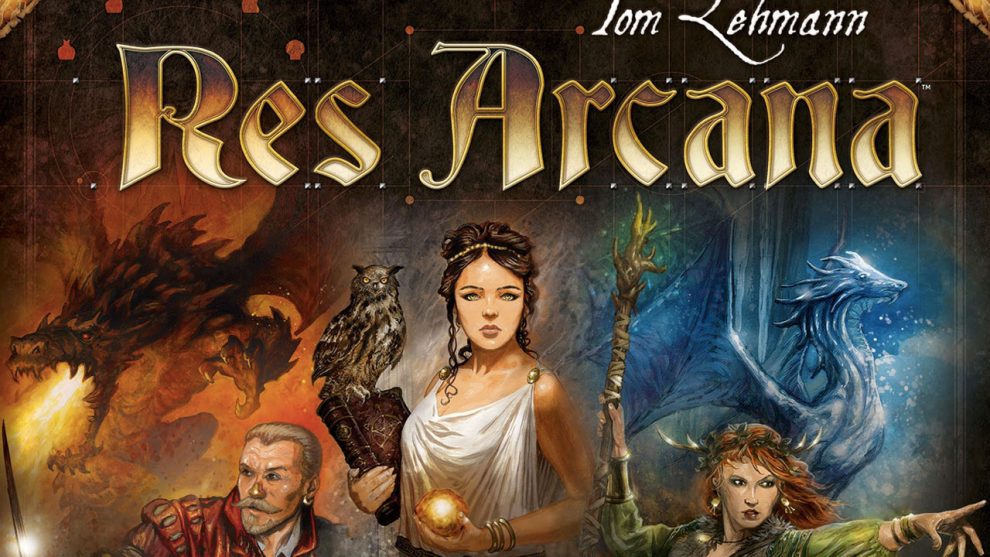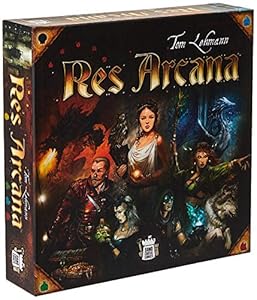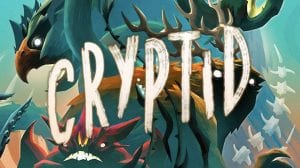Much like anyone who has been lurking in the tabletop world for way too long, I am very familiar with Tom Lehmann’s work. This was a designer who worked with Rio Grande Games for over ten years producing all sorts of great works such as Race for the Galaxy, Roll for the Galaxy, and New Frontiers. He worked alongside Matt Leacock designing several of the Pandemic expansions. The man has a reputation within the industry that is rightfully deserved, especially if you are a lover of tableau and engine builders like yours truly. When I heard about Res Arcana being his latest project, I had to give it a shot.
Res Arcana pits two to four wizards in a contest to show each other who is the best spellslinger of them all. You are going to do this by buying monuments, acquiring places of power, using magic items, and conjuring artifacts as you try to race your way to ten victory points.
Plans Within Plans
Everyone will start out with a deck of eight Artifact cards either at random or through a drafting system. You will carefully examine your deck and select your one mage from the two that were randomly given to you. You will also pick a magic item from a dwindling pool of eight. Now you are ready to begin.
Despite what you might have heard, this is not a deck builder. Those eight artifact cards are all that you are working with. Before the first turn is taken, Res Arcana demands you figure out what your plans are. You will need to target a Place of Power or two and find an optimal route to get them before other players do like a hungry banker going after a foreclosed home.

Places of Power are where most of your victory points will be generated and gain new powers. These giant cardboard tiles must be bought first before using them and they will inform you on how you will get your points. For example, the Dragon’s Lair can get you two victory points if you exhaust the Dragon’s Lair and a Dragon artifact card, while the Catacombs of the Dead will give you a point for every five Death essence you spend or when you exhaust it. Grabbing these places of power is the source of most of the game’s tension.
Essence is your currency. You have blue, red, green, black, and gold. They do have specific names like black being Death, but for the sake of both our sanities, we’ll stick with the colors. Gold is the more valuable resource that is often used for potent artifacts or if you have four of them, to purchase a Monument. Monuments are permanent cards that grant you one to three victory points and a power that could help you along with your journey to ten victory points. As you probably guessed, acquiring places of power or playing artifact cards from your hand will require you to spend essence of particular types.
Now we have gone through the core concepts, let’s talk about how the game flows.
Play-By-Play Action
Each round is separated into three phases: Collect Essence, Do Actions, and Check Victory. Collect Essence is your basic income phase where you collect income from particular cards and if there is any essence placed on your components due to particular card powers, you may take them at this point.
The Do Action phase is the meat and potatoes of Res Arcana. Starting with the First Player and going clockwise, each player will do one action such as playing cards from their hand and placing it in front of them or using a card’s power to do all sorts of things such as exchange one type of essence for another. This will keep going around and around until all players decide to pass and then the Check Victory step is performed to see if anyone has reached 10 victory points or higher.
Doing only one action at a time is brilliant for several reasons. Besides the usual “keeps the downtime at a minimum” as one would expect, it gives players time to react to another’s maneuver. Let’s say a player decides to summon a Dragon artifact card that attacks all of their rivals; all players on the table will be given one turn to react to this new development. It’s a great system that gives plenty of agency to the players.
Another reason is it’s easy to keep track of the current game state. Since everyone is performing their strategy one step at a time, players can easily see the state of the situation they are in and figure out if they can execute whatever they want to do in a timely manner. It also creates tension for players who might be eyeing the same monument or place of power.

Outside of the usual acquiring monuments, playing cards, or using powers, there is one particular action that I love: Discarding a card for one gold or two essences. In a session of Res Arcana, don’t be surprised that you might only use 2 or 3 cards out of a tiny deck of 8. This game is about building an efficient engine, not an elaborate one. Your strategy will involve using a few cards while abusing the rest of the deck to fuel that engine with essences and gold. It also makes drafting an interesting affair since you can “hate draft” and use those unwanted cards to fuel your main engine.
Passing Itself is s Skill
Passing is yet another element that you cannot ignore. If you are the first player to pass, you will get the First Player marker that is worth one victory point by itself, which means, yes, this will be something that will be fought over. The magic item that you picked at the start of the game would be put back into a common pool and you must pick a different one for the next round. Think of magic items as temporary powers you will use for the next round such as spending a resource to draw one card or spending four essence to get two gold. Like the First Player marker, this will be contested between players as well.
All these elements conjure a game session where each player will approach the game vastly different because of the eight artifact cards. You might start your game with a Celestial Horse that provides very flexible income, I might have Sacrificial Pit that destroys my artifacts after I used them to gain more essence, and Jane over there has a Vault that is providing her one gold per turn and income if she leaves the gold the vault (loan interest, get it?)
This is what gives Res Arcana replay value. Everyone goes through an arc, as expected in these types of games, but how I approach the beginning, middle, and end will be vastly different than your approach. Towards the end, we will be announcing our actions one at a time to each other like some awkward Shakespearian play until one of us reaches the ten victory point threshold.
I just wish the first expansion, Lux et Tenebrae, was already in the game because deep-diving into the base game will show the sharp rocks down below.

A major issue with the game is the cards not matching up the situation at hand. Each place of power requires a particular way to score points. Some places of power might require a dragon artifact card, a creature artifact card, or a certain combination of essence to spend in order to get points. If your deck doesn’t match the requirements of the places of power, the session ends up being an exercise of frustration as you try to spin your deck much like a car tire spinning through a Canadian winter. This is not to say the game becomes impossible to win since I have done it on several occasions, but the lack of a safety net mechanism or alternatives makes it very hard for even experienced players to trudge through a tough situation.
The biggest culprit is the player scaling. At the three-player count, Res Arcana has just the right amount of tension. Two-player games are still quite playable but you aren’t contesting so much for the monuments or places of power because there are so many of them. The fatal issue is the four-player count.
Simply put, there aren’t enough places of power or monuments to accommodate a four-player game. What tends to happen is one player in the group will often be in a position where they might not even have a place of power because there are so few of them, or the monument deck runs out thus making the player virtually impossible to reach ten victory points. I’ve seen it happen and I had these situations fall onto my lap like an unsolicited cat.
The good news is the expansion fixes everything I just mentioned.
A Useful Addition
To the untrained eye, the Lux et Tenebrae expansion simply adds more stuff. This is true to some extent; you will get new artifacts, mages, places of power, magic items, and monuments. What makes this expansion so vital is what it does with these new components.
At the back of the expansion manual, it shows a chart of how many places of power and monuments should be in the game depending on the player count. Now you will get consistent tension throughout all player counts and you can play up to five players. Nothing more to say, it’s fixed, let’s move on.
The new mages, places of power, and monuments are perfectly fine additions to the game but the key feature is they now accommodate the demon artifact cards.
In the base game, you had creature artifacts and dragon artifacts. Creature cards are your utility that can also be exploited by certain places of power. Dragon cards give you a victory point, allow you to attack your rivals, and can be exhausted with places of power like Dragon’s Lair.
Demons are like a hybrid of a creature and a dragon. They are more focused on utility, but they are designed to exploit your rival’s current state. For example, you can get essence based on how much gold one rival has or how many demon cards are in play.
The most notable change is the scrolls and the two new magic items.
The first magic item is Illusion. Getting this item allows you to exhaust it whenever you use a power that requires the use of a demon, dragon, or creature card. Let’s say you have a Dragon’s Lair, you can exhaust the Dragon’s Lair and the Illusion magic item to get your two points instead of exhausting a Dragon card. Nice touch.
The scrolls are the breadwinner of the expansion. There is a pool of eight scrolls alongside the ten magic items. When you grab a scroll, you place it in front of you, and it is put back into the pool once you have used it. Unlike magic items, they aren’t forced back into the pool when you pass.
Many of these scrolls are alternatives to the magic items, just with a heftier cost. Some of them are tools to defense against setbacks that you might encounter. Have an artifact that isn’t doing as well as you thought? Get the Destruction scroll and destroy the artifact to get your essence back. Did someone take your place of power? Just grab the Transform scroll to turn all one of essence color to another and start aiming for a different one. This is what I meant when I said alternatives and safety nets.
Almost at the finish line. Would I recommend Res Arcana?
Four-player games is where I would only recommend if you get the expansion. I am not a fan of the four-player experience in the Res Arcana base game. It turns this wonderful game into a bloody mess due to a lack of everything. Someone in that four-player game isn’t going to get the good bits of Res Arcana and will leave on a sour note.
If you are aiming for two or three players, I highly recommend checking this game out. This is one of the greatest examples of a game with high replay value and heavy decision making without any bloat involved often found in complex games. Best of all, it can be played very quickly and within a very acceptable timeframe. I will even dare say that this is Tom’s best work. Yes, that includes Race for the Galaxy. Fight me.
You can purchase this game at Amazon US












Add Comment